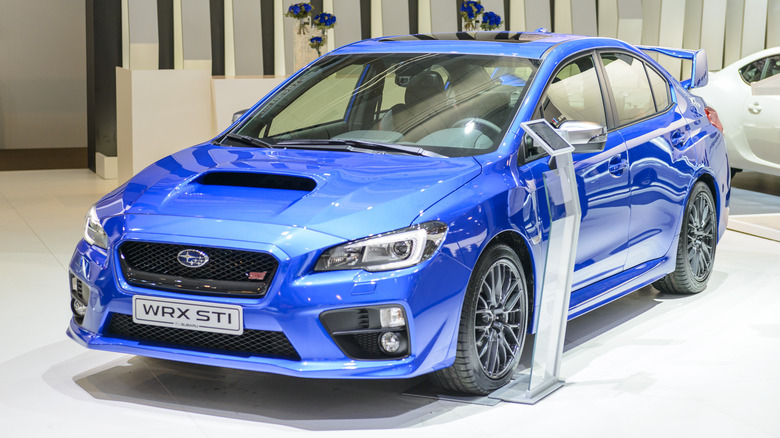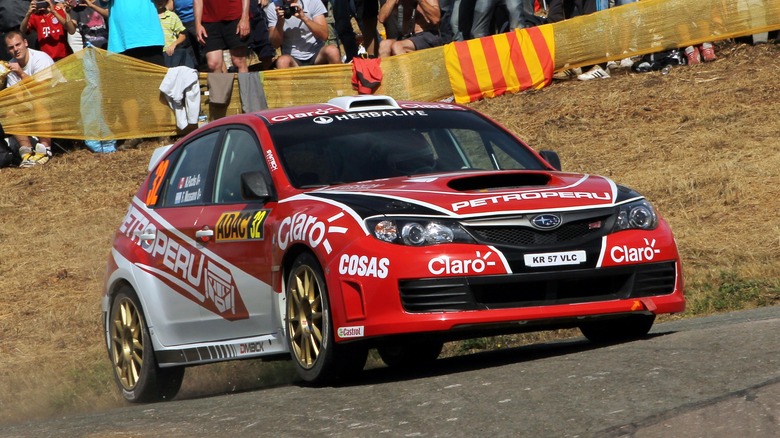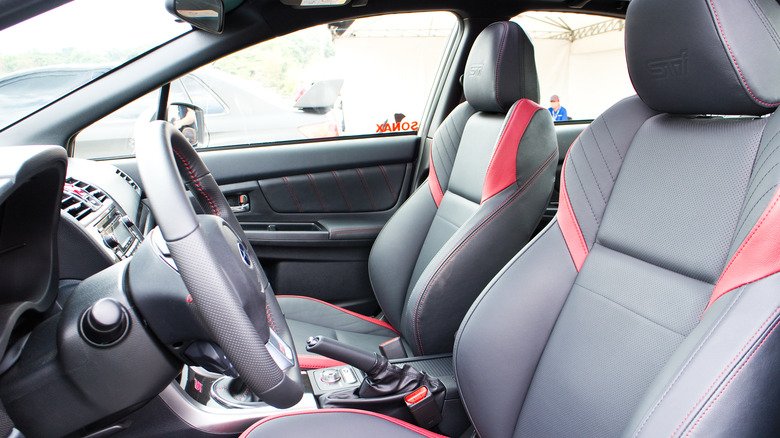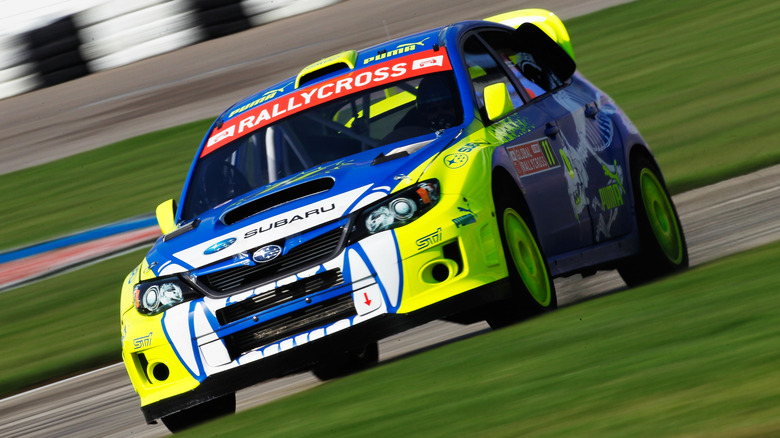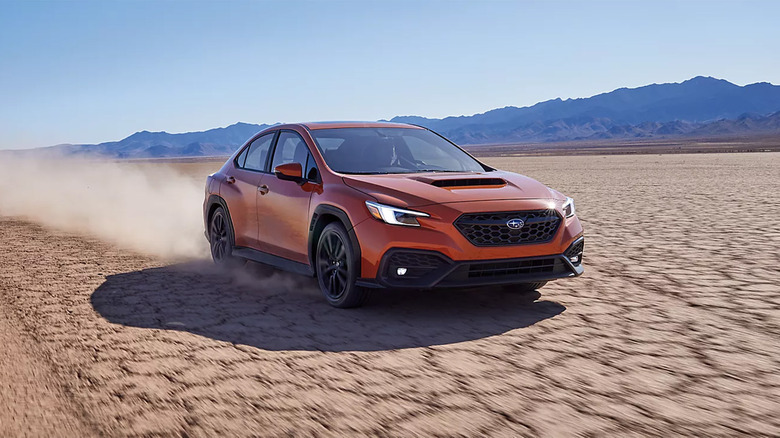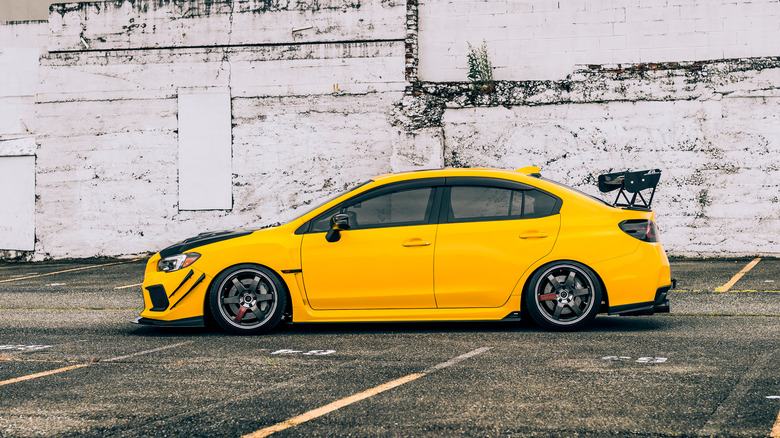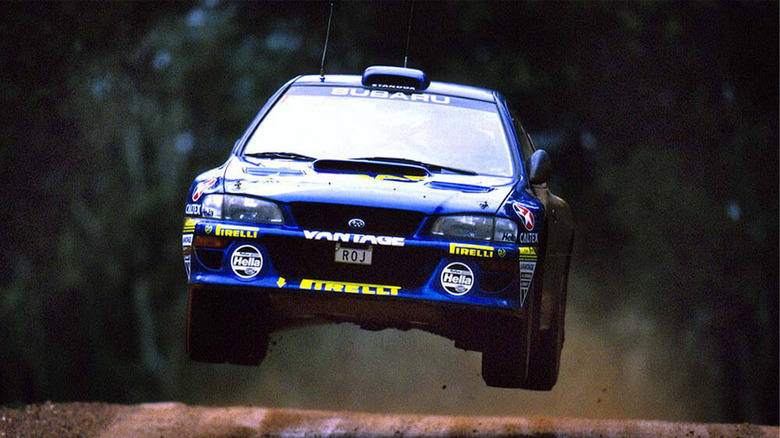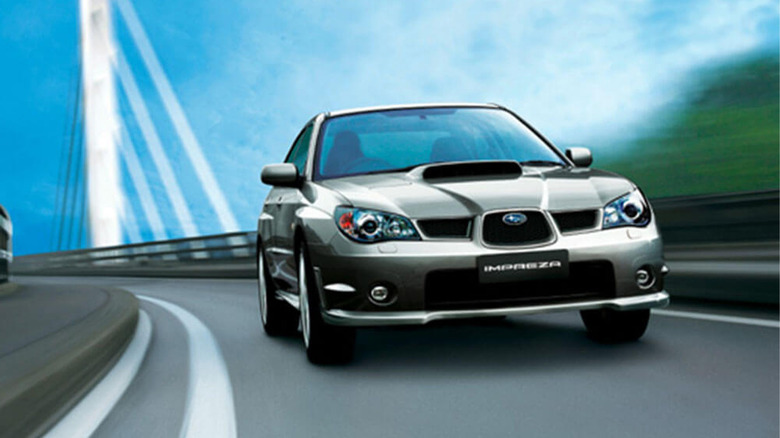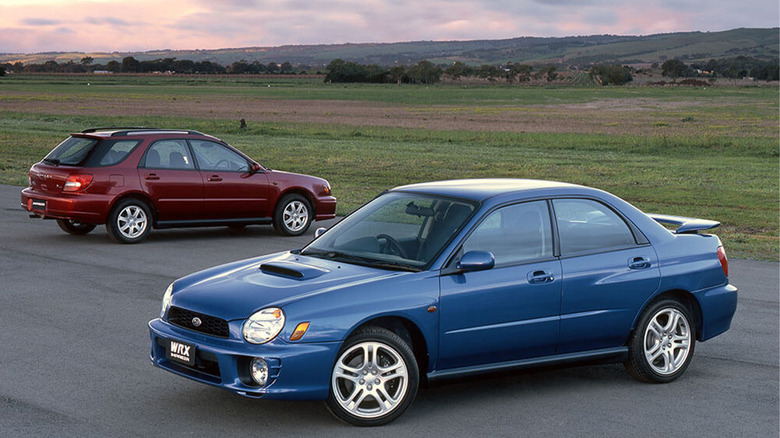Every Generation Subaru WRX Ranked Slowest To Fastest According To Driver Tests
Subaru has been making the WRX in some form since the early 1990s. The first one launched in Japan in 1992. It has since been Subaru's performance-oriented car on par with products like the Honda Civic Type-R, Kia Stinger, and Hyundai Elantra N-Line. It's a unique product in the small performance car space. It's one of the few that offers all-wheel drive as standard equipment. All WRX models have used a turbocharged version of Subaru's iconic boxer engine, so you know what you're getting when you get into one. Fans often refer to the WRX as the "Rex," and it's one of Subaru's most popular vehicles.
As of this writing, there are five generations of the Subaru WRX. Subaru will often refresh the car within a generation, so there are more than five total models. For example, the second generation had two facelifts over the course of its run. Additionally, the WRX often comes in both hatchback and sedan models, so there are well over a dozen different WRX models out there in the wild.
Considering that WRX stands for World Rally Experimental, and the WRX has had a very successful time on the rally car circuit (especially in Australia where it's won several championships), this list will focus on each WRX model ranked by speed.
Did you know the first WRX was actually an Impreza?
Before the results of the driver tests are revealed, it's important to understand the history of the WRX. The WRX is known as its own model these days, but it didn't start there. Subaru first sold the Impreza as its own carthen created a WRX version of the car specifically for rally racing. These performance variants of the Impreza became known as the WRX and WRX STi. The vehicle wasn't sold in the U.S. at the time, with most going to Australia or Japan.
It wasn't until the second generation of the car that it was sold in the U.S. and other countries. It replaced the 2.5RS as the performance variant of the Impreza in the U.S. market. Even so, the vehicle was an Impreza first and a WRX second. This continued through 2007 and into the third generation. In both generations, the WRX was the performance version of the Impreza while the WRX STi was the performance version of the WRX.
It wasn't until the fourth generation started in 2014 that Subaru finally dropped the Impreza nameplate and made the WRX its own product. Subaru has since canceled the sedan version of the Impreza, making it a hatchback-only vehicle. The company is even bringing back the RS version originally seen in the first generation for the 2024 model year, giving the WRX some competition within its own brand.
Methodology
This list will focus primarily on zero-to-60 MPH times. Not only is it a common method of measuring vehicle speeds, but car reviewers often use it during their reviews. That makes the data consistent and reasonably easy to find for a wide variety of cars, including older Subaru WRX models. Since the zero-to-60 time is so common, it was the logical starting point for determining the fastest Subaru WRX generations.
Using zero-to-60 times also helps with accuracy. Car reviewers often test cars on the same track or strip of road, which means the testing conditions are about as consistent as car testing can get. There are several factors that can affect a car's performance, including environmental variables such as elevation, temperature, and even humidity. Additionally, reviewers often receive brand-new cars to test. That means every car a reviewer tests has minimal engine wear, minimal tire wear, new fluids, and no aftermarket modifications that can change the times in a significant way. In short, the conditions are about as controlled as they can be for this type of thing.
Fortunately, most Subaru WRX models are within a second of each other most of the time. In cases where the times are too close, we also looked at zero-to-100 MPH times, quarter-mile splits, and other measurements where they were available. However, such information is often difficult to verify, so we only used those types of measurements sparingly.
Aftermarket
This list will also omit aftermarket modifications for the Subaru WRX. Such data can be difficult to gather and verify. There are modified versions of the Subaru WRX that can absolutely smoke a stock model, but that's true in every generation. Since those modifications and times are self-reported and conducted in a range of different conditions, it wouldn't be completely fair to judge a whole generation based on what one person said they did.
However, just because aftermarket modifications won't be considered, doesn't mean they can't yield eye-popping results. Here is a 1,400-horsepower Subaru WRX putting up an eight-second quarter-mile split with a max speed of 184 MPH. This 845-horsepower WRX STi reportedly did a zero to 60 run in 1.9 seconds, which is on par with some supercars. Another red WRX wagon put up an 8.98-second quarter mile with a max speed of 153 MPH. The claimed world's fastest Subaru can do a quarter mile in 7.19 seconds at 197 MPH.
Perhaps the most famous modified Subaru WRX is the one that set records at Nürburgring's Nordschleife and the Isle of Man TT. For the former, the plucky four-door sedan put up a time of six minutes and 57.5 seconds, which is almost as fast as a Porsche 918 Spyder. It's also the fastest any four-door sedan has ever completed the lap. That same car went to the Isle of Man TT and recorded the fastest lap ever performed by a four-wheel vehicle. Only motorcycles can do it faster. That Subaru is based on the 2017 model, which is from the fourth generation of WRX.
5. Fifth generation
The newest generation of the Subaru WRX is slower than its predecessors in some ways, and quicker in others. It all depends on how you want to measure it. The car features a 2.4-liter turbocharged Subaru Boxer engine that makes 271 horsepower and the company's symmetrical AWD system. There are four trim levels for the fifth generation along with the option for either a manual or a CVT transmission. Other than that, the trim levels seem to only add creature comforts. All of them use the same engine.
The car is pretty quick, but it trades places with the prior generation. Various reviewers have tested the fifth generation WRX and we've seen times as high as 6.0 seconds and as low as 5.4 seconds. That's a bit slower than the previous model. However, Edmunds tested the zero-to-100 MPH speeds, and it showed that the fifth generation was a hair faster than the prior generation. Of course, the fourth generation WRX STi is faster overall, so the fifth generation gets the bottom spot on the ranks for now.
There is some hope for the fifth generation. The STI variant brings the zero-to-60 time down to a flat five seconds, which is not bad at all for a stock car. Plus, those who enjoy the aftermarket can already find parts for the latest gen despite it only being about a year old. This version of the WRX is still in the middle of its run, so it may see speed and performance improvements as the generation ages.
4. Fourth generation
The fourth generation of the Subaru WRX is just a hair faster than the car that replaced it. At its peak, the turbocharged four-cylinder boxer in this model pushed 305 horsepower. That's higher than the fifth generation, but this version of the car was also, on average, slightly heavier as well. Like the fifth generation, the fourth generation had four trim levels along with the STI variant, which had three trim levels of its own. Altogether, there were up to seven variants of the WRX in any given model year.
For zero to 60 times, the fourth generation was capable of doing it in under five seconds. Most reviewers could get it at around 5.3 to 5.5 seconds. However, we found several examples of the STi models going as fast as 4.6 seconds, although it remains entirely possible those vehicles could have been modified in some way. Even so, on average, the fourth generation had faster times than the fifth generation in reviews.
Some of the fastest WRXs ever were fourth generations, though, so the engine can definitely output a lot more power with aftermarket considerations. The aforementioned Subaru set various lap records modeled after the 2017 model year. Yes, that car likely has tens of thousands of dollars worth of mods, but it's still possible. Despite having pedestrian numbers as a stock model, the fourth generation is among the most iconic in the WRX family.
3. First generation
The first-generation Subaru Impreza WRX is probably in a good spot as the third fastest generation of the WRX. The original model was specifically built for racing back in the 1990s and early 2000s. It also spent its entire life outside of the U.S. with a much larger impact in Australia. Subaru introduced the WRX STI as we know it back in 1994, although variants of the WRX existed as early as 1992. There were six engine changes during the first generation. At its lowest, the STI came with a 250-horsepower engine with 228 pound-feet of torque. In the end, that was increased to 280 horsepower and 260 pound-feet of torque. The regular WRX had four engine swaps as well.
Due to the engine changes, it's actually quite difficult to find a consistent set of zero to 60 times for this generation of WRX. The WRX STI with the version VI engine topped out at around 4.6 seconds, which was the fastest time we could find that was backed up by multiple sources. On average, most WRX models from the first generation were around 5.1 seconds. Those are all very respectable times, and still measurably faster than the newest models, at least when getting up to 60 MPH.
In the aftermarket circuit, we were able to find one 1996 Subaru WRX that did a 4.2-second zero to 60 run with a 13-second quarter mile along with a 1998 Subaru Impreza WRX 22B STi that did a 5.1-second run that helped back up previous data. Most early Subaru WRXs were built for rally car racing rather than straight-line speed. Thus, there are plenty of examples of a WRX winning racing championships, even if they didn't record speed times.
2. Third generation
The third generation of the Subaru WRX was a quick little car. It debuted in 2007 and lasted until 2014. It was also the final Subaru WRX to include the Impreza name. It was spun off into its own badge starting with the fourth generation. This model was powered by a 301-horsepower Subaru Boxer engine that was also turbocharged like all the others. It also marked the departure of the bug-eyed design that the second generation was known for. This generation had a few different variants of the STI, which resulted in a few different engines.
At its most powerful, the WRX STi Spec C Type RA-R was capable of doing a very impressive zero-to-60 run in 4.5 seconds. The regular third-generation STi could do it in 4.9 seconds, and Motortrend clocked one doing 4.7 seconds. On average and bone stock, most third-generation models clocked in at most 5.2 seconds. This is where ranking the top two gets difficult. Technically, the first generation was faster on average by one-tenth of a second, but there are examples of the third generation being faster overall.
They could go even faster if pushed a little bit. Topspeed had a lightly modified version that clocked in with a 4.4-second zero-to-60 time. There are many self-reported times of high four-second times, but those cars could have modifications are not publicly known. This is about as fast as the first generation overall and not far off from the fourth generation.
1. Second generation
While this entire list is essentially a game of inches, it's a game of inches that the second generation of the Subaru WRX wins. The second generation also has an interesting history. It was only around from 2000 to 2007 but saw two massive facelifts in the middle of the generation. Among other things, the car got consistently faster with each facelift. The final facelift added a new engine, which made 293 horsepower and 290 pound-feet of torque that really let the car zoom.
On average, the second generation matched the third generation with an average of around 5.2 seconds for a zero to 60 run. However, the second generation had the fastest single WRX ever produced, which is the 2004 Subaru STi WR1. It had a zero-to-60 time of 4.2 seconds or 4.3 seconds depending on who you ask. Most other generations can't get that fast without aftermarket modifications. We were able to find multiple examples of the 2004 STi WR1 being that fast, and it helps carry the second generation to the top of this list.
Zero To 60 Times, a website where folks can self-report their track times, reported two valid times for the second-generation model. One is a 2004 Subaru Impreza WRX STi WR1 and the other is a 2003 M2 Performance Subaru Impreza WRX. They had times of 4.2 seconds and 4.4. seconds, respectively. The only Subarus on the list faster than those are a 1996 Subaru Impreza WRX at 4.2 seconds and a 2010 Subaru WRX STi Cosworth CS400 Hatchback with a 3.6-second time. Clearly, the 2010 model is modified, but that's what you have to do to beat that iconic 2004 model.
